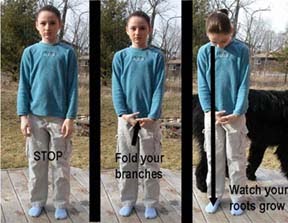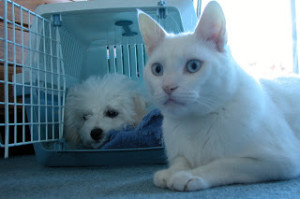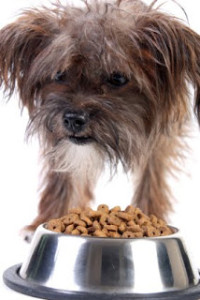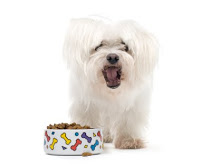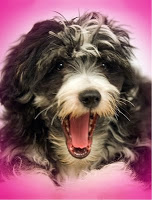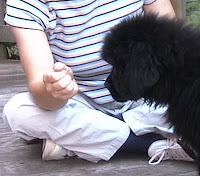“STOP PUPPY FROM BITING – PART 1”
By Joan Orr and Teresa Lewin
This is the first in a series of posts with tips on how to stop your puppy from biting. We get many emails with questions from puppy owners about biting. This series of posts is intended to answer these questions. If you have a question about puppy biting that is not answered in this series, please send your question to the author: joan@doggonecrazy.ca
Our extremely popular Be a Tree program teaches kids to stand still if a strange dog comes near or any dog is bothering them or acting too frisky. Every major dog bite prevention program and dog behaviour expert recommends some version of standing still and avoiding eye contact as the best way to prevent dog bites. This is because movement is a powerful trigger for dogs, whether they are in predatory mode, are threatening or guarding or are simply playing. Being a tree is boring and non-threatening to dogs and they will soon lose interest and go away.But what happens when the Be a Tree strategy does not work right away? In some cases a dog is so excited that it jumps up, pokes or nudges, nips or pulls on clothing even if the person stands still. No matter what the dog does it is always best to remain still. Any movement will make the dog even more excited and will make the situation worse. Even if the dog does bite, pulling away or moving could cause the dog bite again or to bite harder.
What if Being a Tree Doesn’t Work?
Parents have sometimes reported to us that this is all very well, but their puppy sometimes gets hold of the child’s clothes and keeps on tugging and sometimes nips by accident even if the child stands still. This is a particular problem with toddlers and preschoolers, who really can’t be expected to stand still while the puppy is tugging madly at their clothes. Even if there is a rare toddler that can stand still, there is still resistance for the puppy to tug against and this can be enough fun to keep the puppy at it.There is no question about it … puppies love to chase toddlers. They are small, they squeal, they run, they behave erratically. They meet every requirement for the perfect squeaky toy as far as the puppy is concerned. It is so much fun for the puppy to chase the toddler and tug on his clothes, that even repeated punishment and scolding from the parents is not enough to stop it. In fact adding the parents to the chase can often cause the puppy to reach even greater heights of wild excitement.
Puppies naturally like to play rough games and they will play this way with your toddler and young children if they get the opportunity. It is essential that the puppy and the children learn how to behave appropriately around each other. Watch this video to see how wound up puppies can get. You certainly don’t want your puppy to try to play this way with your children!
A Multi-Faceted Approach
The best way to solve the problem of puppy biting is to take a multi-faceted approach. Here we will talk about two things that you can do. We will discuss further measures in future blog posts in this series.
Institute a management program to limit the interaction between the puppy and small children.
Teach the puppy to chase and bite a toy instead of you and your children.
A Management Program
Dog behavior and training experts agree that it is essential to institute a management program to keep both children and puppies safe. This includes using a crate for the puppy to sleep in, placing gates to restrict the puppy’s access, teaching children to respect the puppy’s sleeping and eating areas and his toys and supervising all interaction between child and puppy.
Parents have said to us, “We got the puppy for our child. What is the point of having a dog and keeping it locked in a crate all the time? We want the dog to be part of the family.”
Of course you want the dog to be part of the family! But a family member who chases and bites the toddler is soon out of favor and no-one is happy. The best way to keep both toddler and puppy safe and happy is to keep them apart until they both learn how to behave around the other and to supervise closely when they are allowed limited contact with each other. It is best if the puppy never learns to chase and bite the toddler. If he never has the chance to do this, then he will never do it. If he has already had some fun with this, it is not too late to prevent it from happening again and to teach him more acceptable forms of entertainment.Here is a link to a great book you should buy (pictured to the right) that will help you create a situation in which the puppy becomes a great family member.
Let’s talk briefly about crate training. Crating a puppy is not cruel, in fact if the training is done properly the crate is a sanctuary for the puppy. It gives him a safe and comfortable place to go to sleep, chew on his toys in peace or to get away from noisy children. Watch this video that shows two different puppies who can’t wait to get into their crates.
Here’s another example of a dog that loves to go into her crate:
It is not unusual for a young puppy to sleep 20 hours a day and there is no reason why all this napping should not be done in the crate. When the puppy is out of the crate he should have your undivided attention for play and training. Once he is tired out, back he goes into the crate with a stuffed Kong, bone or other special chew toy for another nap (we will do a blog post on our recommended toys). We know that you are desperate for the puppy and toddler to nap at the same time. We have been there and we know how exhausting it is to look after a toddler, puppy, baby, other kids and dogs etc. If there are times when they are both awake at once, then it is essential to supervise at all times. You may need to put the puppy on a leash so that he does not get the chance to chase the toddler.
Give the puppy access to only his own toys. The child’s toys should be in a playpen, or in an area to which the puppy has no access if the puppy is allowed to roam the house. Once the puppy is older and has some training you can teach him to leave things alone that are not his, but at first he will not know the difference between his toys and the child’s toys. Remember the puppy is just a baby too and you can’t expect him to know anything about how things work in a human household until you have taught him.
Teach the children that when the puppy is in his crate, no-one is to bother him. With your permission they can give him treats in the crate by dropping them through the bars. Teach the children to respect the puppy’s toys and bones and never to bother him while he is eating or to take anything away from him. Teach the children to Be a Tree if the puppy gets excited and never to run away screaming. We will discuss this further in subsequent blog post in this series.A good time for the toddler to interact with the puppy is when the puppy is tired out. The toddler can sit with you and the puppy and gently pet the puppy and talk to him while he falls asleep. When the puppy is asleep, pick him up and put him in the crate.
Once the puppy learns to chase a toy and bring it back, young children can participate in supervised games of fetch.
Download the Doggone Crazy parent guide that has a section about safe and dangerous games.
Teach the Puppy to Chase and Bite a Toy
A great way to teach your puppy not to bite you and your kids is to drag a toy on a string for him to chase. This is great fun for the puppy and conditions him to run with kids without biting them. When we have a puppy around we take the toy on a string everywhere. We always keep one in the car so we won’t be without it. Always trade for a treat to get the toy back. If young kids are going to do this, then it is up to the parent to get the toy back. We have a video showing this with a 5 year old child and an 8 week old puppy on our Clicker Puppy DVD.
Here is a video showing the same thing with an older child. This is a sneak peak from our upcoming DVD: Positively Perfect Puppy. This dog is a Puli, which is a sheepdog bred to chase and nip. Even with this breed of dog which is hard wired for chasing and nipping, the toy on a rope is irresistible and more fun than biting at the child. Occasionally he does get interested in the child and tries to pull on her clothes. She stands still and gets him interested in the toy and the game is back on. She is teaching the puppy to give the toy back using food and a clicker. She puts the food near his nose and when he lets go of the toy she clicks and gives him the treat. Soon he will let go on his own as soon as she stops and she will be able to reward this by starting the game again.
If you have young children, play this game with the puppy yourself for a while until he is very engaged with the game before your kids try it. Be sure to supervise to make sure that you are there to take the toy back and get the game started again and to prevent the puppy from becoming interested in chasing the child rather than the toy.
STOP PUPPY FROM BITING – PART 2
By Joan Orr and Teresa Lewin
This is the second article in our series on how to teach a puppy not to bite.
Please note that these instructions are intended to prevent guarding. All puppy owners should do these exercises even if the puppy is not guarding. It is much easier to prevent guarding than to cure it. We will post a future article about how to cure guarding in a puppy.
Many bites to children occur around the food bowl. We are frequently told that the dog growls (but he would never bite of course) when the kids go near him while he’s eating. This situation is easily prevented if the puppy is taught that people approaching the food bowl means good things for the puppy.
The best way to prevent food guarding is to go up to the puppy while it is eating (adults only; not children at first) and toss something extra yummy near the food bowl. Progress to adding the treats right into the bowl. Children can toss treats towards the bowl once the puppy gets the idea that people approaching is a good thing. Soon the puppy will welcome the approach to his bowl with a wagging tail. If the dog raises his tail when a person approaches the food bowl, this is a serious warning. Watch out for this raised tail warning. Other signs that the dog is worried about people stealing his food include, blocking the food bowl by moving his body, growling, freezing and staring at the food or the person, or gobbling at an alarming rate. Recognize these warnings as an impending problem and go back to conditioning the dog to welcome approach by adding yummy treats once again.This approach can be used to prevent other types of resource guarding as well. For example, if the puppy is lying on his mat chewing a bone, the kids can walk past and toss really yummy treats onto the dog’s mat. Similarly if the dog has a toy, the kids can toss treats in the direction of the dog and keep walking. The puppy will soon come to view any approach by a person as benign and will not become defensive.
Many people are of the unfounded belief that taking the bowl (or other high value object) away and giving it back is a way to teach the dog to accept this. Actually this teaches the dog to mistrust people coming near the bowl. The action that occurs immediately following the approach of the person is the taking of the desired object. Even if the object is subsequently returned, it is the taking away that becomes associated with the approach of a person. Using this approach could increase bite risk for children and visitors to the home since the dog will assume that any person intends to take his treasures and he may be less tolerant than with the ruling adult.
Another important lesson is the exchange. Obtain two identical bones or Kongs and stuff them with goodies and give one to the puppy. Take the second one and show it to the puppy right under his nose. When he focuses on the second one and starts licking it, take the first one away. Repeat several times per session by walking away and returning to make the exchange. The puppy will soon get the idea that people taking things away is a good thing. If a child ever takes from the dog the possibility of a bite is greatly reduced (children should still be taught not to take anything away from the dog, but best to be prepared in case it does happen). The exchange can also be used to regain stolen objects from the puppy. Instead of punishing the puppy, trade for something the puppy wants more and say “give” or “off” at the same time. The puppy will learn to give up objects willingly at the “give” command, thus reducing the likelihood of a tug-of-war happening between child and dog.
If resource guarding problems do develop despite your best efforts to prevent them, or the dog is an adult rather than a puppy, don’t delay, seek professional help from a trainer that will use positive methods to solve the problem. Remember, it is critical that the puppy or dog learn that it is a VERY GOOD thing when people come near. Any training approach that involves punishing, startling or frightening the puppy to distract him from growling will make things worse. Never punish a puppy for growling, or allow others to do this. The puppy may learn not to growl and may go straight to a bite the next time, or when you are not there to mete out the discipline. The puppy may become even more worried about kids around his food or toys if bad things happen in the presence of kids.
Resource guarding can develop into a very dangerous situation – a ticking time bomb – with a tragic outcome becoming more and more likely as time goes on. Click here to find a trainer.
STOP PUPPY FROM BITING – PART 3
This is the third in our series on How to Stop Puppies from Biting. In a previous article we talked about how to prevent food and object guarding in puppies and here we talk about how to fix this problem if it has already started. Please note that the topic here is PUPPIES not adult dogs. If you have an adult dog that is guarding food or possessions or a resting place then we recommend that you hire a professional behavior consultant to help you. This is a very dangerous situation and we would consider this an emergency that requires professional help immediately. If you efforts to follow the instructions below with you puppy are not successful, then please get professional help right away. Once your puppy is cured and even if your puppy never shows signs of guarding, it is important to keep up with these exercises for the life of the dog and not to get into the habit of just taking things away from the dog because he seems to tolerate it.This article is reprinted with permission from Jean Donaldson
Resource Guarding in Puppies
By Jean Donaldson
Dear Jean,
I just got a new nine week-old Rottie puppy. He’s stunning, smart and generally friendly but growls and snaps if I go near him while he’s eating. He also does this to my adult Rotties. I’ve never seen this in a puppy so young. Is he some sort of lemon? Is he a dominant dog? Is there anything I can do? Help!
It is indeed alarming for most people to see frank aggression in puppies. In the case of resource guarding – food, bone, bed etc. possessiveness – there is good news and bad news. The good news is you can start addressing it in a young, hopefully plastic, spongy puppy with weak jaws. The bad news is that there is some sentiment out there among trainers that aggression in puppies is an insidious sign of the problem having Deep Genetic Roots and therefore fruitless to tackle. I’m going to explore the whole nature-nurture debate later but for now will simply say that there doesn’t seem to be any overwhelmingly tidy correlation between behavior problems that are thought to have a strong genetic component and their susceptibility (or lack thereof) to behavior modification.
I recently had a similar case, in my own foster puppy. Buffy, a stray six week-old Chow, presented with object and food guarding against people and dogs. I elected to not touch the dog-dog issues, which is a relatively common approach. Her socialization and play skills were coming along nicely and she was developing good acquired bite inhibition. The guarding against people, however, needed to be actively resolved. The following is a summary of Buffy’s food guarding exercise regime. Incidentally, Buffy also presented with socialization deficits and severe body handling problems, which were also addressed, as was her object guarding. The key to good hierarchy design is small enough incremental steps that at no point do you see the original guarding problem. In the case of a puppy, such as this, there may actually be more aggressive increment jumps. I did a few other things in the can’t-hurt-might-help category. These included impulse control (stay, off and wait) and extra soft-mouth training.
Baseline
When approached while eating from her dish, Buffy would freeze and, if approach continued, growl briefly and then lunge and snap. If touched while eating, she would growl simultaneous to whirling and biting. Due to the independent body-handling problem, this had to be partly resolved prior to combining it with food bowl exercises. Buffy did not guard an empty dish.Hierarchy
Step 1 (day 1): Installment feeding of canned food. I sat on the floor next to Buffy’s dish and spooned in one mouthful. Once she had swallowed, I spooned the next mouthful into her dish. By the end of the second meal, she demonstrated a clear happy anticipatory orientation to my spoon hand after each swallow.
Step 2 (day 1-2): Overlap. This was essentially the same as Step 1 except that I added the next spoonful to her dish while she was still consuming, always a much dicier proposition. We did this for three meals without evidence of guarding seen.
Step 3 (day 2-3): Approach overlap. I was now standing. I spooned larger installments, withdrew two paces, re-approached and added the next spoonful while Buffy was still consuming. So, this combined approach with the overlap exercise. We stuck with this for three meals, at end of which time a Conditioned Emotional Response (CER) had become evident – Buffy wagged and looked up on approach. We then repeated the exercise for one more day (5 small meals) with larger withdrawal distances and intervals.
Step 4 (day 4): Trumping. Now I spooned her entire puppy-sized ration into her bowl. I withdrew five paces, paused 15 seconds, approached and added a (hidden) marble-sized dollop of goat cheese. I had pre-auditioned the goat cheese out of context and ascertained it to be in Buffy’s Top Five All Time Foods. I withdrew to six paces and waited for Buffy to continue to consume – this was not immediate (typical of trumping – dog orients to handler rather than back to dish) – then repeated. On the third trial I got a clear CER– withdrawal from bowl on approach, orientation to me and tail wag. Clever little thing.
Step 5 (day 4-6): Covering High Value Base. To up the ante, I tried some approaches while she was consuming a top food (bowl of treats), rather than normal meal ration level food. I trumped it with higher value stuff (gorgonzola). In two trials, I once again saw her happy anticipatory CER, a very rapid curve indeed.
Step 6 (day 4 onward): Cold Trials. To better simulate real life, I initiated random trumping. At least once per meal, from a random direction, at a random time and with one of Buffy’s top foods, I approached and added the bonus. Better than 80% of the time, I got an evident “yippee” CER. At no point did she guard.
Step 7 (day 8 onward): Generalization. I recruited my husband, colleagues in my office and a neighbor to do some random trumps, with careful monitoring for any evidence of regression, including the absence of “yippee” CERs to their approach. Had this been an adult dog, the hierarchy – and, notably, a much more gradual one too – would have been recommenced at the beginning by each new recruit, with likely accelerated progress rate for each successive person.
Step 8 (day 15 onward): Body Handling. It was only here that I commenced patting, grabbing or pushing her around while she was eating. In most cases this would come earlier (prior to cold trails), however with Buffy it took me this long to get the independent body-handling problem up to speed. The handling during eating exercise consisted of the body touch (later handling) followed by a trumping addition, repeated until the body touch/handling elicited the “yippee” CER. Buffy’s CER consisted of a wag as well as orientation to my hand. If I stored the bonus in my other hand behind my back or my pocket and reached with a blank hand, she would wag and orient to my face.
Buffy is now on maintenance with a cold trumping or body handling trial usually once per meal and use of other people whenever an opportunity presents itself. I ended up adopting her.
STOP PUPPY FROM BITING – PART 4
By Joan Orr
Teach the puppy to give kisses instead of biting.
Teach the puppy the meaning of a cue that means “take your mouth off” and subsequently “leave your mouth off”.
How to Give Kisses
Most puppies are generous with kisses and you can encourage this by saying “kisses” and welcoming the kisses when the puppy offers them. Of course if you don’t want the puppy slobbering all over you, then just ignore the kisses or move the attractive body part out of range. Your puppy will soon learn that if you say “kisses” you will welcome his licking you and otherwise you will not welcome this. Never scold or punish or take away your attention altogether from a kissing puppy.
A great way to encourage kisses instead of biting and to help a puppy learn to take treats gently is to put something like cheese spread or peanut butter on your hand and fingers (don’t use peanut butter if your puppy is going to be around children though in case of children with peanut allergies). Let the puppy lick this off, while you say the word “kisses” over and over. This helps him associate the action of licking with the word “kisses”. If he is really frantic for the yummy stuff on your hand he may not be paying too much attention to what you are saying, so it could take a while for the association with the word to sink in. For some puppies this exercise is all that you will need to do teach him what “kisses” means, but others may not seem to catch on.
A better way to ensure that the puppy is thinking about what he is doing and not just madly licking is to set up the situation so that he offers a lick and is then reinforced for that so that he will repeat it with the conscious thought of doing it. To do this you need some kind of marker sound that tells the puppy he is doing the right thing. I use a clicker for this, but you can use a ball point pen or something else that makes a short sharp sound. You can also use a marker word such as “yes” or “yip”, but this does not work as well as using a clicker. Here is a video that shows how to do this. The puppy in this video was the nippiest puppy I have ever worked with and she rarely offered spontaneous kisses – she had much more fun nipping!
Offer a treat that leaves a tasty residue on your hand (put a dab of cream cheese under the treat if necessary to get things started). Click when the puppy licks and give another treat. Create the cycle: lick – click – treat – lick – click – treat. At first the puppy is just licking the treat residue of my fingers, but after a few tries she is offering a lick on purpose. Add the cue “kisses” when the puppy offers a lick when you hold out your hand. Use this cue from now on when offering treats. Gradually move from a more open hand presentation to holding the treat between thumb and forefinger. Click when the puppy licks and release the treat. Eventually the puppy will learn that the offering of a treat is the cue for “kisses” and he will lick to get the treat rather than snatching it. Practice with different people in different location. If the puppy makes a mistake such as biting at your hand or putting his paw on you, just ignore this. You don’t need to say “no” or “ah ah” or “oops” if the puppy makes a mistake. It is best just to be quiet and let the click be the only communication during this training session. The training session in this video was about a minute and a half – this is plenty long enough. After training, play for a few minutes and then do another short session. You will get much more out of five 1 minute sessions than out of one 5 minute session.
STOP PUPPY FROM BITING – PART 5
By Joan Orr M.Sc.
This is the fifth in our series about how to stop your puppy from biting. Please read the previous installments, since we won’t be repeating information and you will want to know why it is important to teach your puppy how to bite softly and then not at all. All the strategies we offer are important and you should use them all. Click here to see all the parts in this series. Some of this article is excerpted from an article published at clickertraining.com. Click here to view the entire article if you want more details and more advanced steps once your puppy has the basic idea.Teach the Puppy to Leave It
An important strategy in helping the puppy to learn what he can and cannot bite and whether he is biting too hard is to teach a cue that tells the puppy to leave it. Some people use the cue “leave it” or “out” or “off”. In our example we will use the word “off”. You can use whatever you want, just be sure that this word is unique for the purpose. For example, you would not use this to tell the puppy to get off the couch or to take his paws off you. Choose a word that is going to be easy for you to remember to use in a consistent context.
Command vs Cue
Many people train “off” as a command with its associated threat: “Leave it or else.” The trouble is, once the dog has swallowed the light bulb (I am not making this up), or Granny’s $3000 hearing aid, the ensuing “or else” does not do much to remedy the situation. It is not as if you can dock the dog’s allowance or extract an IOU to pay for the costs of his transgression. Experienced clicker trainers, especially those whose training goals require an exceptional degree of reliability (those who work with guide dogs, service dogs, bomb detection dogs, etc.), know that training cues rather than commands produces a dog that can be counted on even in very difficult situations. Be sure to watch the video clips at the end of this article to see the results of training with cues using clicker training.
It is important to understand the difference between a cue and a command. A command implies a threat: “Do it or I will make you.” A command is given before the behavior is learned, and it can be enforced if the dog does not comply. For example, a trainer may teach “sit” by pushing down on the dog’s rump while saying sit, repeating the word and action over and over until the dog figures out that the word sit goes with the action of sitting, and that sitting fast enough will prevent the rump pushing. In the early stages of this kind of training, the dog associates the command “sit” with all kinds of stimuli and with actions that have nothing to do with the dog sitting on its own. Eventually after much frustration he figures it out.
“Off” is commonly trained as a command by placing a temptation near the dog and holding him back, or tugging on his leash and saying “off” in a stern tone of voice. If the dog does manage to grab the prohibited item, the command is repeated while the item is forcibly removed from the dog’s mouth. This method is stressful for the dog, and he may not learn much. In many cases, the command approach may place the trainer at risk of being bitten, too.
A cue is completely different from a command. There is no threat implied with a cue. A cue is like a green light that tells the dog that now is the time to execute a behavior for the chance of reinforcement.
A cue is attached to a specific behavior only after the dog is offering the behavior on his own. The “sit” cue, for example, is only given once the dog has learned to sit, and, therefore, the cue is not associated with anything other than the act of sitting. If the dog does not respond to a cue, a trainer knows that further training is required. The trainer does not assume that the dog is intentionally misbehaving and must be forced or helped to do the behavior.
Getting the Behavior
A common and very reasonable question about teaching cues is, “How do you get the dog to sit or demonstrate the goal behavior in the first place, so that you can click/treat and eventually add a cue?”
An easy way to get the puppy to take his mouth off your hand so that you can then click (or say yes) and reinforce was described by Carolyn Clark (click here for the original article) and summarized here.
A popular method is to hold a treat in your closed fist and allow the dog to sniff, lick, paw it—whatever he wants to do to try to get the treat. Keep your fist closed until he backs off for just a fraction of a second, then click and open your hand to give him the treat. Alternatively, you can click when he backs off, and give him a better treat from your other hand. Avoid the temptation to say anything—no scolding or otherwise telling him not to pester your hand. The dog learns best if he figures it out for himself without fear of reprisal.
If the dog is too frantic to get at the treat, use something less tantalizing to start. If the dog loses interest and does not try to get the treat, use something more tantalizing.
Raise criteria gradually so that the click/treat comes only when the dog is deliberately moving his head back several inches from your hand. Raise criteria again so that the click/treat comes only when the dog makes eye contact with you after moving away from your hand. Gradually require longer periods of eye contact, until the dog backs off from your hand and maintains eye contact for three seconds. Now is the time to add the cue “off.”
Show the dog your fist containing the treat. When he looks away from it and toward you, say “off,” click, offer the treat, and say “take it.” Teaching opposite cues in pairs like this is a really effective approach. From now on, always say “take it” when you give a treat after the dog responds to the “off” cue.
Video Demonstration
Here is a video demonstrating the method by super trainer Emily Larlham. Emily uses the cue “leave it”. Notice the tone of voice; there is no threat. Note the extreme reliability of the behavior. Emily puts a plate of food down, asks the dogs to leave it and leaves the room. We recommend that you watch all of Emily’s training videos!
